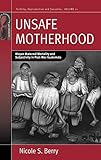Unsafe Motherhood : Mayan Maternal Mortality and Subjectivity in Post-War Guatemala / Nicole S. Berry.
Material type: TextSeries: Fertility, Reproduction and Sexuality: Social and Cultural Perspectives ; 21Publisher: New York ; Oxford : Berghahn Books, [2010]Copyright date: ©2010Description: 1 online resource (260 p.)Content type:
TextSeries: Fertility, Reproduction and Sexuality: Social and Cultural Perspectives ; 21Publisher: New York ; Oxford : Berghahn Books, [2010]Copyright date: ©2010Description: 1 online resource (260 p.)Content type: - 9781845457525
- 9781845459963
- Childbirth at home -- Guatemala -- Santa Cruz La Laguna
- Maternal health services -- Guatemala -- Santa Cruz La Laguna
- Mothers -- Mortality -- Guatemala -- Santa Cruz La Laguna
- Pregnancy -- Complications -- Guatemala -- Santa Cruz La Laguna
- Prenatal care
- SOCIAL SCIENCE / Anthropology / General
- Guatemala
- Maternal Mortality
- Mayans
- development
- global health
- latin america
- maternal death
- maternal health
- medical anthropology
- midwifery
- midwives
- motherhood
- pregnancy
- the Maya
- 362.198
- RG530.3 .G9 B57 2010
- online - DeGruyter
| Item type | Current library | Call number | URL | Status | Notes | Barcode | |
|---|---|---|---|---|---|---|---|
 eBook
eBook
|
Biblioteca "Angelicum" Pont. Univ. S.Tommaso d'Aquino Nuvola online | online - DeGruyter (Browse shelf(Opens below)) | Online access | Not for loan (Accesso limitato) | Accesso per gli utenti autorizzati / Access for authorized users | (dgr)9781845459963 |
Browsing Biblioteca "Angelicum" Pont. Univ. S.Tommaso d'Aquino shelves, Shelving location: Nuvola online Close shelf browser (Hides shelf browser)
Frontmatter -- CONTENTS -- List of Figures -- Acknowledgments -- Prologue. The Story of Rosario -- Introduction. The Specter of Death -- Chapter 1. Life, Birth, and Death in the Village -- Chapter 2. Coming to the ER: Analysis of an Interaction -- Chapter 3. Global Safe Motherhood and Making Local Pregnancy Safer: The Spin and What It Covers Up -- Chapter 4. The Indio Bruto and Modern Guatemalan Healthcare -- Chapter 5. Everyday Violence: From a Kaqchikel Village to the Nation and Back -- Chapter 6. Praying for a Good Outcome: Staying at Home during Obstetric Problems -- Conclusion. Putting the “Maternal” Back in Maternal Mortality -- Notes -- Bibliography -- Subject Index -- Index to Ethnographic Vignettes
restricted access online access with authorization star
http://purl.org/coar/access_right/c_16ec
“[S]heds light not only on the obstacles to making motherhood safer, but to improving the health of poor populations in general.”—Social Anthropology Since 1987, when the global community first recognized the high frequency of women in developing countries dying from pregnancy-related causes, little progress has been made to combat this problem. This study follows the global policies that have been implemented in Sololá, Guatemala in order to decrease high rates of maternal mortality among indigenous Mayan women. The author examines the diverse meanings and understandings of motherhood, pregnancy, birth and birth-related death among the biomedical personnel, village women, their families, and midwives. These incongruous perspectives, in conjunction with the implementation of such policies, threaten to disenfranchise clients from their own cultural understandings of self. The author investigates how these policies need to meld with the everyday lives of these women, and how the failure to do so will lead to a failure to decrease maternal deaths globally. From the Introduction: An unspoken effect of reducing maternal mortality to a medical problem is that life and death become the only outcomes by which pregnancy and birth are understood. The specter of death looms large and limits our full exploration of either our attempts to curb maternal mortality, or the phenomenon itself. Certainly women’s survival during childbirth is the ultimate measure of success of our efforts. Yet using pregnancy outcomes and biomedical attendance at birth as the primary feedback on global efforts to make pregnancy safer is misguided.
Mode of access: Internet via World Wide Web.
In English.
Description based on online resource; title from PDF title page (publisher's Web site, viewed 25. Jun 2024)









